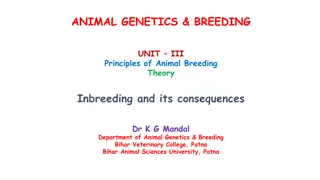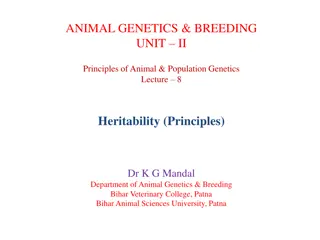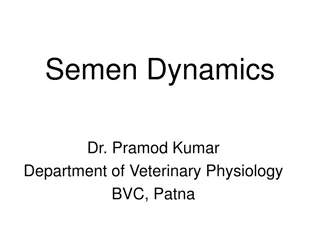Techniques and Benefits of Sperm Sexing for Livestock Breeding
Separating X and Y sperm for selective breeding allows for the production of desired male or female offspring in livestock. Various techniques such as Quinacrine Mustard Staining and Raman Micro-Spectroscopy are used to differentiate between the two sperm types based on DNA, size, surface charges, and antigen differences. The advantages of sex-sorted semen include cost reduction, improved genetic selection, and reduced dystocia risk.
Download Presentation

Please find below an Image/Link to download the presentation.
The content on the website is provided AS IS for your information and personal use only. It may not be sold, licensed, or shared on other websites without obtaining consent from the author. Download presentation by click this link. If you encounter any issues during the download, it is possible that the publisher has removed the file from their server.
E N D
Presentation Transcript
SPERM SEXING SPERM SEXING (SPERM SORTING) (SPERM SORTING)
Sperm sexing Separation of X-sperm from Y-sperm from the semen for producing either male or female Practically many differences between X-sperm from Y-sperm which can be depend on these differences to differentiate between them There are many techniques for sperm sorting
Benefits of Sex-Sorted Semen 1-Determination of sex at the earliest stage can reduce the management cost thorough selective management of superior bulls or cows 2-Calves of desired sex can be produced. 3-Dystocia can be reduced by preventing production of male calves 4-It lowers the cost of progeny testing programs and embryo transfer and enhances the value of genetic markers 5-Fewer quantity of sexed sperm is used in genetically superior dairy females for heifer replacement
Sperm sexing techniques Many different techniques for sorting Y and X bearing sperm All these techniques are mostly based on many theoretical differences in X and Y sperm as follow: 1-The X-sperm contain more DNA than the Y-sperm. -The degree of differences varies from species to species which reach approximately 3-4% 2-The size of X-sperm larger than Y-sperm 3-The surface charges on sperm (Y-sperm has a positive charge and X-sperm has a negative charge) 4- Cell surface antigens between X and Y sperm 5-Y-sperm swim faster than X-sperm.
1- QUINACRINE MUSTARD STAINING Quinacrine mustard staining produces very intense fluorescence to certain regions of chromosome to verify X- or Y-sperm enrichment, In this technique Y-chromosome bearing sperm exhibit a fluorescent spot while X-chromosome bearing sperm remain unstained Quinacrine some times produces false positive and false negative results. Therefore, it is considered an inappropriate approach for selection of sperm for most mammalian species.
2- RAMAN MICRO-SPECTROSCOPY Raman spectroscopy depend on component of the sperm (DNA, protein, lipids, etc.), to differentiate between X- and Y-sperm The nucleus reveals the main biochemical differences between X- and Y-sperm. Raman peak positions and relative intensities are consistent in all regions of Y-sperm than X-sperm Raman spectroscopy is highly efficient and non invasive technique for sperm sexing
3- CENTRIFUGAL COUNTER CURRENT DISTRIBUTION BASED ON DENSITY CHARACTERISTIC The difference in density between X-bearing bovine spermatozoa and Y-bearing bovine spermatozoa to be only 0.0007 g/cm3 This feature can be use to differentiate between Y and X sperm by centrifugal counter current distribution by using an aqueous two-phase system
4- ALBUMIN GRADIENT Successful separation of X and Y-bearing spermatozoa using an albumin gradient This technique is depend on the Y chromosome is smaller than X chromosome This technique was not accurate for differentiation The method is effective in increasing the proportion of spermatozoa with motility and elimination of abnormal forms
5- SWIMMING PATTERNS UNDER LAMINAR FLOW This method was based on Y-bearing spermatozoa swim differently and more quickly than X-bearing spermatozoa in a column of flowing media. This technique is not always accurate
6- PERCOLL DENSITY GRADIENT This method was based on Y-bearing spermatozoa swim more quickly than X-bearing Semen is layered on top of a percoll column and spermatozoa are allowed to penetrate the column. This technique is not always effective in separation of X or Y-bearing spermatozoa
7- FREE FLOW ELECTROPHORESIS It is based on the possibility that the electric charge on the surface of X-bearing spermatozoa differs from that of Y-bearing spermatozoa In this technique the semen is expose to electric field to separate spermatozoa into the X or Y However this technique is not always accurate
8- COUNTER CURRENT GALVANIC SEPARATION Application of a suitable micro-ampere current attracts Y-bearing spermatozoa to the anode and X-bearing spermatozoa to the cathode However this technique is not always accurate
9- IMMUNOLOGICAL SEXING OF SEMEN The technique based on the presence of special antigen (H-Y antigen) on the surface of sperms In this technique the using of anti-X antisera resulted in agglutination of X bearing spermatozoa but not Y bearing spermatozoa The agglutinated sperm population was separated from the free-swimming sperm by glass wool filtration
10- POLYMERASE CHAIN REACTION (PCR) Specific DNA sequences on X- and Y-sperm have been reported which can be used to identify the sex of individual sperm and sex ratios of sperm in semen sample Accurate determination of the sex ratio using single sperm PCR want analysis of a large number of individual sperm However, sex ratio of semen can be determined more simply and accurately by quantitative real-time PCR (qPCR)
11- FLOWCYTOMETRY This technique based on the fact that X sperm contains 3 4% more DNA than Y sperm In this method the sperms treat with fluorescent dye (Hoechst 33342), which binds to the DNA Due to more DNA content in X sperm, it takes more stain than Y sperm In the flowcytometry a special laser detector can differentiate between X and Y sperms according to the intensity of fluorescence dye This method is regard an accurate method for sorting the sperms























